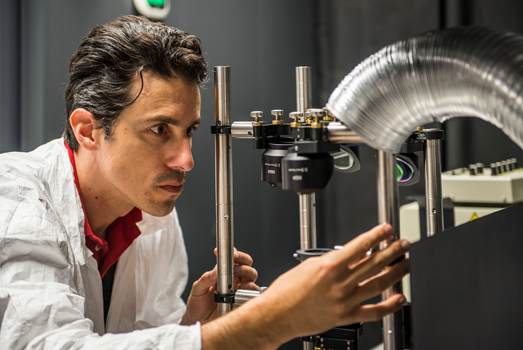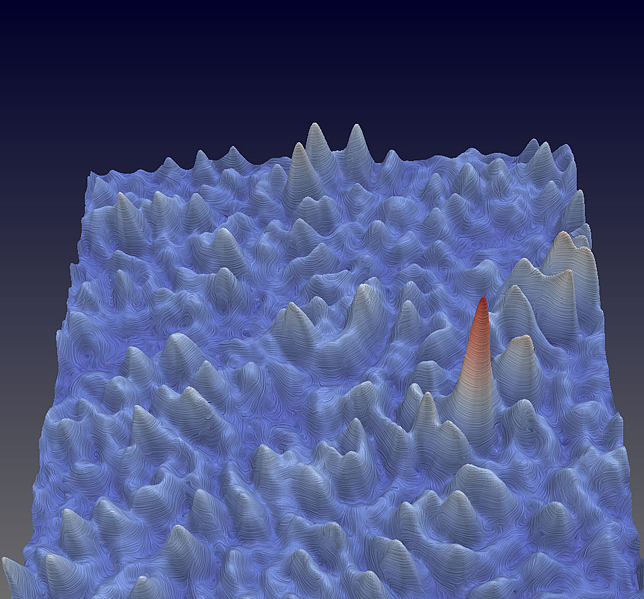Tsunami on demand: the power to harness catastrophic events

Andrea Fratalocchi led a team of researchers from KAUST and European universities and research centers to develop a chip capable of generating nanoscale rogue waves.
A new study published in Nature Physics features a nano-optical chip that makes possible generating and controlling nanoscale rogue waves. The innovative chip was developed by an international team of physicists, led by Andrea Fratalocchi from KAUST (Saudi Arabia), and is expected to have significant applications for energy research and environmental safety.
Can you imagine how much energy is in a tsunami wave, or in a tornado? Energy is all around us, but mainly contained in a quiet state. But there are moments in time when large amounts of energy build up spontaneously and create rare phenomena on a potentially disastrous scale. How these events occur, in many cases, is still a mystery.
To reveal the natural mechanisms behind such high-energy phenomena, Andrea Fratalocchi, assistant professor in the Computer, Electrical and Mathematical Science and Engineering Division of King Abdullah University of Science and Technology (KAUST), led a team of researchers from Saudi Arabia and three European universities and research centers to understand the dynamics of such destructive events and control their formation in new optical chips, which can open various technological applications. The results and implications of this study are published in the journal Nature Physics.
"I have always been fascinated by the unpredictability of nature," Fratalocchi said. "And I believe that understanding this complexity is the next frontier that will open cutting edge pathways in science and offer novel applications in a variety of areas."
Fratalocchi's team began their research by developing new theoretical ideas to explain the formation of rare energetic natural events such as rogue waves — large surface waves that develop spontaneously in deep water and represent a potential risk for vessels and open-ocean oil platforms."
"Our idea was something never tested before," Fratalocchi continued. "We wanted to demonstrate that small perturbations of a chaotic sea of interacting waves could, contrary to intuition, control the formation of rare events of exceptional amplitude."

Fully experimental image of a nanoscaled and ultrafast optical rogue wave retrieved by Near-field Scanning Optical Microscope (NSOM). The flow lines visible in the image represent the direction of light energy.
A planar photonic crystal chip, fabricated at the University of St. Andrews and tested at the FOM institute AMOLF in the Amsterdam Science Park, was used to generate ultrafast (163 fs long) and subwavelength (203 nm wide) nanoscale rogue waves, proving that Fratalocchi's theory was correct. The newly developed photonic chip offered an exceptional level of controllability over these rare events.
Thomas F. Krauss, head of the Photonics Group and Nanocentre Cleanroom at the University of York, UK, was involved in the development of the experiment and the analysis of the data. He shared, "By realizing a sea of interacting waves on a photonic chip, we were able study the formation of rare high energy events in a controlled environment. We noted that these events only happened when some sets of waves were missing, which is one of the key insights our study."
Kobus Kuipers, head of nanophotonics at FOM institute AMOLF, NL, who was involved in the experimental visualization of the rogue waves, was fascinated by their dynamics: "We have developed a microscope that allows us to visualize optical behavior at the nanoscale. Unlike conventional wave behavior, it was remarkable to see the rogue waves suddenly appear, seemingly out of nowhere, and then disappear again…as if they had never been there."
Andrea Di Falco, leader of the Synthetic Optics group at the University of St. Andrews said, "The advantage of using light confined in an optical chip is that we can control very carefully how the energy in a chaotic system is dissipated, giving rise to these rare and extreme events. It is as if we were able to produce a determined amount of waves of unusual height in a small lake, just by accurately landscaping its coasts and controlling the size and number of its emissaries."
The outcomes of this project offer leading edge technological applications in energy research, high speed communication and in disaster preparedness.
Fratalocchi and the team believe their research represents a major milestone for KAUST and for the field. "This discovery can change once and for all the way we look at catastrophic events," concludes Fratalocchi, "opening new perspectives in preventing their destructive appearance on large scales, or using their unique power for ideating new applications at the nanoscale."The title of the Nature Physics paper is "Triggering extreme events at the nanoscale in photonic seas." The paper is accessible on the Nature Photonics website: http://dx.doi.org/10.1038/nphys3263

